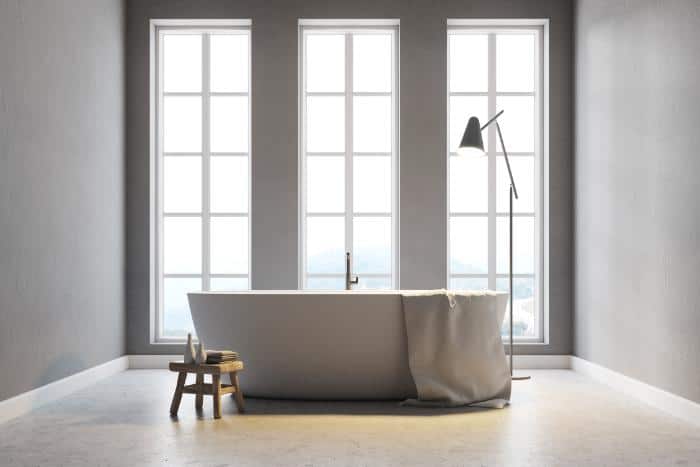San Diego Tile Refinishing Near Me
Is your bathroom or kitchen looking worn and outdated? Over time, tiles can lose their shine, and grout lines can become discolored or damaged. Replacing tiles can be costly and time-consuming, but there’s a better option—tile refinishing near me. This process gives your tiles a fresh, modern look without the need for complete replacement.
At FG Tub & Tile, we specialize in professional tile refinishing services, providing homeowners and businesses with an affordable, long-lasting solution to make their tiles look brand new again. Whether it’s your tile shower, kitchen countertops, or bathroom surfaces, our expert team is ready to help you achieve stunning results.

What is Tile Refinishing and How Does It Work?
Understanding the Tile Refinishing Process
Tile refinishing (also known as resurfacing) is a process where a new, durable coating is applied over the existing tile surface to restore its appearance and protect it from further wear. This technique eliminates the need to remove and replace old tiles, offering a cost-effective way to breathe new life into your bathroom or kitchen.
Here’s a step-by-step breakdown of the tile refinishing process:
Surface Cleaning: Our team starts by thoroughly cleaning the tiles and grout lines, removing any dirt, soap scum, and grime that may affect the refinishing process. This ensures a smooth and even surface for applying the new finish.
Tile and Grout Repair: Any cracks, chips, or damage to the tile or grout are repaired to ensure a seamless finish. This step helps to extend the life of your refinished surface.
Application of New Finish: A specially formulated coating is applied to the tiles. This creates a smooth, durable finish that’s resistant to moisture, stains, and scratches.
Curing Time: Once the new finish is applied, it requires time to cure. In most cases, the refinished surface is ready to use within 24 to 48 hours.
By using this method, you can dramatically improve the look and feel of your tiles without the mess, time, or cost of a full replacement.
Why Choose Tile Refinishing Over Tile Replacement?
Save Time and Money with Tile Refinishing
Replacing your tiles entirely can be expensive and time-consuming. The cost of demolition, new materials, labor, and installation quickly adds up, especially in larger areas like bathrooms and kitchens. In comparison, tile refinishing services can save you up to 75% of the cost while delivering equally stunning results.
Aside from the obvious cost savings, here are some additional benefits of choosing tile refinishing:
Time-Saving: Refinishing typically takes just one day to complete, whereas a full replacement can take a week or more.
Eco-Friendly: Refinishing allows you to reuse your existing tiles, reducing waste and the environmental impact associated with manufacturing and transporting new materials.
Minimal Disruption: No demolition means no dust or mess in your home, and you can start enjoying your new surfaces much sooner.
Where Tile Refinishing Works Best
Tile refinishing is ideal for a variety of surfaces, from kitchen backsplashes to bathroom floors. Here are some of the best areas to consider for refinishing:
Tile Showers: Shower tiles are constantly exposed to water, soap, and cleaning chemicals, which can lead to discoloration and damage. Refinishing your tile shower gives it a refreshed, clean look while protecting it from further wear.
Kitchen Countertops: Kitchen countertops see a lot of activity and can develop scratches or stains over time. Refinishing them restores their smooth surface and gives them a sleek, modern appearance.
Bathroom Tiles: Whether it’s the wall tiles around your tub or the tiles on your bathroom floor, refinishing can make them look brand new again without the hassle of replacement.
Grout Lines: Over time, grout lines can become discolored or damaged, making your entire space look old. Our refinishing process includes repairing and refreshing grout lines to give your surfaces a clean, uniform appearance.

How Tile Refinishing Can Transform Your Kitchen and Bathroom
Benefits of Refinishing for Your Home
If you’re tired of dealing with chipped tiles, stained grout, or dull surfaces in your kitchen or bathroom, refinishing is the perfect solution. Here’s why tile refinishing near me is such a popular choice for homeowners looking to revitalize their space:
Fresh Look Without Replacement: Refinishing restores the original shine and beauty of your tiles, making them look brand new. You can also update the color of your tiles for a more modern style.
Extends the Life of Your Tiles: The new finish not only improves the appearance but also protects your tiles from further damage, ensuring they last longer.
Easy to Clean: The smooth, durable finish makes your tiles easier to clean and maintain. You won’t have to worry about stubborn stains or discolored grout lines.
Increased Property Value: A freshly refinished bathroom or kitchen adds value to your home, making it more appealing to potential buyers or renters.
Whether you’re preparing to sell your home or simply want to improve its appearance, tile refinishing is a cost-effective, low-maintenance solution that delivers impressive results.
Tile Refinishing vs. Painting – What’s the Difference?
Some homeowners may consider painting their tiles as a DIY alternative to refinishing. However, tile painting doesn’t offer the same durability or professional look as refinishing. Here’s why tile refinishing is the superior option:
Durability: Tile refinishing uses a high-quality, chemical-resistant coating that is designed to last. In contrast, paint may chip, peel, or fade over time, especially in high-moisture areas like bathrooms.
Professional Finish: The refinishing process provides a smooth, even finish that looks and feels like new tile. Paint often results in a less polished, uneven appearance.
Long-Term Value: Tile refinishing extends the life of your existing tiles, whereas painting offers only a temporary fix that may require reapplication.
When you choose FG Tub & Tile, you’re getting professional-grade refinishing services that will make your tiles look and perform like new for years to come.
How to Maintain Your Refinished Tiles
Tips for Keeping Your Refinished Tiles in Top Condition
Once your tiles have been refinished, it’s important to maintain them properly to ensure they stay looking their best. Here are some tips to keep your refinished tiles in great shape:
Use Mild Cleaners: Avoid harsh chemicals that can damage the new finish. Stick to mild, non-abrasive cleaners to keep your tiles looking fresh.
Avoid Scrubbing with Abrasive Tools: Use soft cloths or sponges to clean your tiles. Avoid abrasive scrubbers that could scratch the surface.
Keep the Area Dry: Especially in areas like showers or around the tub, ensure the area stays dry to prevent moisture buildup, which can affect the finish over time.
By following these simple maintenance tips, your refinished tiles will maintain their like-new appearance for years, ensuring you get the most out of your investment.
Why Choose FG Tub & Tile for Your Tile Refinishing Needs?
Expert Service and Superior Results
When searching for tile refinishing near me, you want a company that delivers excellent service and high-quality results. At FG Tub & Tile, we take pride in offering:
Experienced Technicians: Our technicians are trained and experienced in providing top-tier refinishing services. Whether it’s a small bathroom or a large kitchen project, we handle every job with care and precision.
Affordable Pricing: We offer competitive pricing on all our refinishing services, ensuring that you get the best value for your money without compromising on quality.
Customer Satisfaction: We’re committed to making sure you’re happy with the results. Our team works closely with you to ensure your project is completed on time and meets your expectations.
Ready to transform your tiles? Contact us today to schedule a consultation and get a free estimate on your tile refinishing project.
Get Started Today – Request a Free Estimate!
If you’re ready to give your kitchen or bathroom a new look, tile refinishing near me is the perfect solution. At FG Tub & Tile, we specialize in delivering high-quality, long-lasting refinishing services that save you time and money. Whether you need to refinish your shower, countertops, or entire kitchen, our team is ready to help.
Call us today or reach out through our website to schedule your free estimate. Let us show you how easy and affordable it can be to transform your home with professional tile refinishing services.
